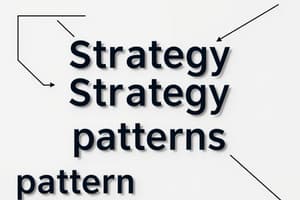Podcast
Questions and Answers
What is the primary focus of object-oriented programming?
What is the primary focus of object-oriented programming?
- Using global variables across functions.
- Encapsulation of data within objects. (correct)
- Modifying data structures dynamically.
- Breaking down programs into procedures.
Which best describes a class in object-oriented programming?
Which best describes a class in object-oriented programming?
- A set of functions operating on inherited attributes.
- An instance of a class that performs methods.
- A user-defined data type that serves as a blueprint. (correct)
- A procedure that manipulates data.
How do methods function within a class?
How do methods function within a class?
- They encapsulate behavior and operations on data. (correct)
- They define the attributes of an object.
- They store static data fields.
- They inherit properties from other classes.
What advantage does object-oriented programming have over procedural programming?
What advantage does object-oriented programming have over procedural programming?
Which concept in OOP allows data hiding?
Which concept in OOP allows data hiding?
What does polymorphism enable in object-oriented programming?
What does polymorphism enable in object-oriented programming?
What is a defining characteristic of attributes in OOP?
What is a defining characteristic of attributes in OOP?
Why is OOP considered more scalable than procedural programming?
Why is OOP considered more scalable than procedural programming?
In what way does procedural programming differ from object-oriented programming?
In what way does procedural programming differ from object-oriented programming?
What is the effect of code intertwining in procedural programming?
What is the effect of code intertwining in procedural programming?
Flashcards are hidden until you start studying
Study Notes
Introduction to Object-Oriented Software Design (OOSD)
- Object-oriented software design (OOSD) utilizes object-oriented programming (OOP) principles to develop modular, reusable, and maintainable software applications.
- OOP is founded on the notion of "objects," which encase data (attributes) and procedures (methods).
- Objects are instances of classes, which act as blueprints defining shared attributes and behaviors.
- OOSD enhances program management and modification, especially in large, complex systems that require frequent updates.
Key Concepts of OOP: Classes, Objects, Attributes, Methods
- Classes: Serve as templates for creating objects, defining their properties and behaviors, functioning as user-defined data types.
- Objects: Specific instances of classes representing real-world entities, possessing unique states characterized by attributes and methods for behavior.
- Attributes: Also called properties, these data fields embody the state of an object and hold pertinent information like name, age, and color.
- Methods: Functions within a class that dictate an object's behavior and how it interacts with its data and other objects, enabling actions like calculations and data manipulation.
Procedural vs Object-Oriented Approach
- Shifting to object-oriented analysis and design signifies a fundamental change in thought processes from data structures and algorithms to objects and their relationships.
- Procedural Programming: Focuses on a sequence of instructions (procedures) acting on data; less modular due to entwined data and code.
- Object-Oriented Programming (OOP): Encapsulates data within objects, providing a modular structure that fosters better abstraction, inheritance, and polymorphism.
Comparison of Procedural and Object-Oriented Approaches
-
Focus:
- Procedural: Functions and procedures with entwined data and code.
- OOP: Objects and interactions with encapsulated data.
-
Code Reusability:
- Procedural: Limited reuse capabilities.
- OOP: Facilitates reuse through abstraction and inheritance mechanisms.
-
Maintainability:
- Procedural: Modifications can affect multiple code segments due to intertwined structure.
- OOP: Keeps changes localized within objects, enhancing maintainability.
-
Scalability:
- Procedural: Difficulties arise when scaling programs due to complexity.
- OOP: Modular structure promotes scalability through well-defined relationships.
-
Real-world Modelling:
- Procedural: Less effective for modelling real-world entities directly.
- OOP: Aligns more closely with real-world entity modeling.
Studying That Suits You
Use AI to generate personalized quizzes and flashcards to suit your learning preferences.





